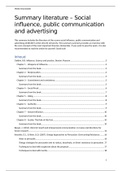Meike Noorlander
Summary literature – Social
infuence, public communication
and advertising
This summary includes the literature of the course social infuence, public communicaton and
advertsing 2018/2019 at the Utrecht University This summary summery provides an overvie ith
the core concepts of the most important theories Remember, if you ant to pass the exam, it is also
recommended to read the artcle by yourself Good luck!
Inhoud
Cialdini, R B Infuence: Science and practce Boston: Pearson 3
Chapter 1 – Weapons of Infuence 3
Summary from the book 3
Chapter 2 – Reciprocaton 4
Summary from the book 5
Chapter 3 – Commitment and consistency 5
Summary from the book 5
Chapter 4 – Social Proof 6
Summary from the book 7
Chapter 5 – Liking 8
Summary from the book 8
Chapter 6 – Authority 9
Summary from the book 9
Chapter 7 – Instant Infuence 10
Summary from the book 10
Chapter 8 – Scarity: The Rule of the Fe 10
Summary from the book 10
Berger, J (2014) Word of mouth and interpersonal communicaton: A revie and directons for
future research 12
Kno les, E S , & Riner, D D (2007) Omega Approaches to Persuasion: Overcoming Resistance 16
Ways to persuade 16
Omega strategies for persuasion aim to reduce, deactvate, or divert resistance to persuasion 17
Techniques to deal ith sceptcism about the proposal 17
Techniques to deal ith inerta 18
1
,Meike Noorlander
Friese, M , Wänke, M , & Plessner, H (2006) Implicit Consumer Preferences and Their Infuence on
Product Choice 19
Abstract 19
Implicit 19
Matz, S C , Kosinski, M , Nave, G & Stll ell, D J (2017) Psychological targetng as an efectve
approach to digital mass persuasion 20
Moyer-Gusé, E (2008) To ard a Theory of Entertainment Persuasion: Explaining the Persuasive
Efects of Entertainment-Educaton Messages 21
Overvie diferent type of categories of involvement ith characters 22
Overcoming resistance ith entertainment programming 23
Gass, R H , & Seiter, J S (2014) The Ethics of Persuasion 25
Persuasion unethical? 25
Ethics, culture, and the issue of central versus peripheral processing 25
Ethical questons that can’t be ans ered through the study of persuasion 26
Our approaches: characteristcs of ethical infuence 26
The key ethical questons regarding persuasive strategies and tactcs and explore possible
ans ers 27
Summary 29
2
, Meike Noorlander
Cialdini, R.B. Infuence: Science and practice. Boston:
Pearson.
Chapter 1 – Weapons of Infuence
Trigger feature: a specifc thing’ that actvate partcular behaviour of animals, like a shade of colour
- Automatc fxed reactons ofen orks very ell
- Preprogramed tapes usually ork to our advantaged, the trigger features that actvate them
can dupe us into playing the tapes at the rong tmes
Example: people ill be more successful if they provide a reason if e ask someone to do us
a favour (copy machine/add because in the request or because just because)
Shortcuts: e have to use stereotypes to classify things according to a fe features and then to
respond ithout thinking hen one or another of these trigger features is present because e don’t
have the tme, energy and capacity
- Judgmental heuristcs: these shortcuts operate in much the same fashion as the expensive =
good rule, allo ing for simplifed thinking that orks ell most of the tme but leaves us
open to occasional, costly mistakes
Automatc or clic, hhirr resoonding: the tendency to react on the basis of a thorough analysis of all
the informaton can be referred to as controlled responding
People are more likely to deal ith informaton in a controlled fashion hen they have both the
desire and the ability to analyse it carefully, other ise they use the click, whirr approach
Contrast orinciole: afects the ay e see the diference bet een t o things that are presented one
afer another Simply put, if the second item is fairly diferent from the frst, e ill tend to see it as
more diferent than it actually is
Example: heavy/light and atractve/unatractve
Perceotual contrast: the same thing can be made to seem very diferent depending on the nature of
the event that precedes it
Example: hot/cold ater and expensive and inexpensive clothes
Summary from the book
- Ethologists, researcher ho study animal behaviour in the natural environment, have notced
that among many animal species behaviour ofen occurs in rigid and mechanical paterns
Called fxed-acton paterns, these mechanical behaviour sequences are note orthy in their
similarity to certain automatc (click, whirr) responding humans For both humans and
subhumans, the automatc behaviour paterns tend to be triggered by a single feature, can
ofen prove very valuable by allo ing an individual to decide on a correct course of acton
ithout having to analyse carefully and completely each of the other pieces of informaton in
the situaton
- The advantage of such shortcut responding lies in its efciency and economy; by reactng
automatcally to a usually informatve trigger feature, an individual preservers crucial tme,
energy, an mental capacity The disadvantage of such responding lies in its vulnerability to
silly and costly mistakes; by reactng to only a piece of the available informaton (even a
normally predictve piece), an individual increased the chances of error, especially hen
responding in an automatc, mindless fashion The chances of error increase even further
3






